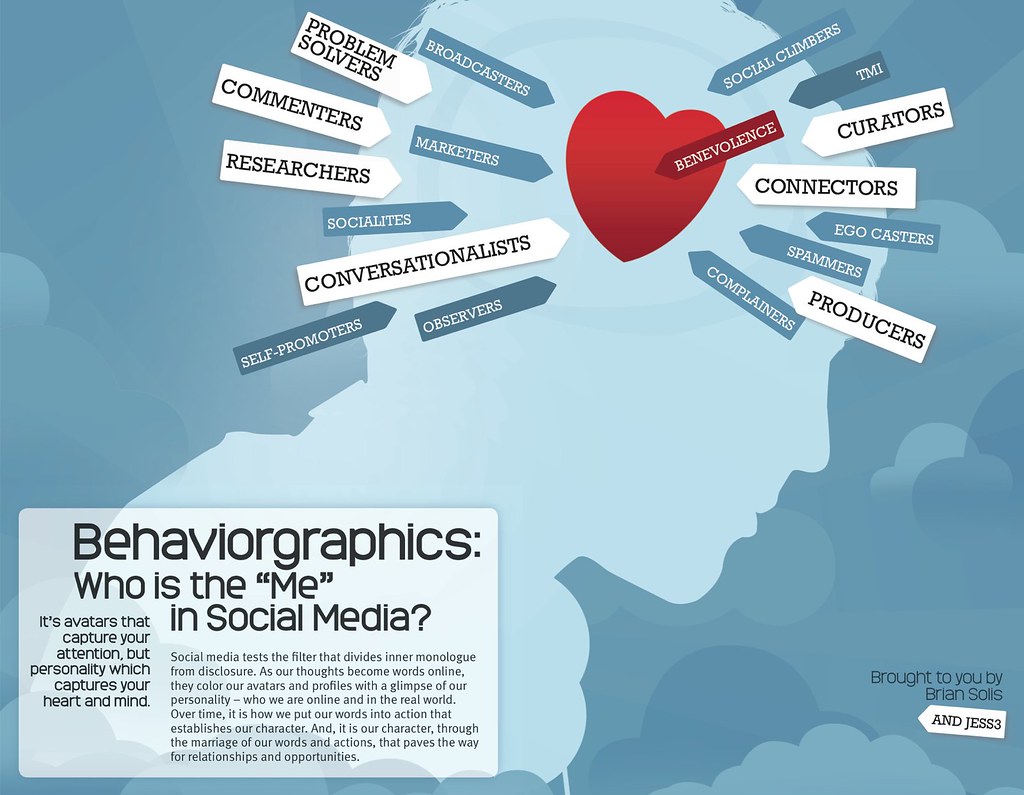
Social media is a deeply personal ecosystem that I lovingly refer to as the EGOsystem. As such, there is a “me” in social media for a reason. It is quite literally a world in which we are at the center of our online experiences, a place where everything and everyone revolves around us.
Placing ourselves in the role of this emerging social consumer for a moment, brands, businesses, and media aren’t sure how to see or reach us directly yet. We’re lured through creative attempts to follow them on Twitter or “Like” them on Facebook. But for the most part in social media, we are faceless consumers brought only to life through avatars, bios and a history of our online activities and connections.
Sometimes we’re part of demographic studies where we’re grouped by age, income, gender, education, etc.. Sometimes, we’re part of psychographic studies where we’re grouped by commonalities, shared interests and passions, and themes. And often, we’re lumped together through keyword mentions or online influence scores. But the real question is, who are we online and what makes us connect, share, and live online? Finding these answers is revealing and hopefully, inspiring.
If ignorance is bliss, awareness is enlightening…
Behaviorgraphics
Last year, I teamed up with my good friends at the JESS3 creative agency run by Jesse Thomas and Leslie Bradshaw to capture the essence of how and why people were “living in public.” The characteristics of online behavior were diverse to say the least. However, I documented recurring traits and organized them into 18 categories.
I’m happy to share that Behaviorgraphics is now available as a free high resdownload and also as a 22 x 28 poster.
Click below for various sizes(free):
3. Poster
Which one/s are you?
At the center is Benevolence – The unselfish and kindhearted behavior that engenders and promotes recognition and reciprocity, and in doing so, earns the goodwill of those around them. This is the hub of social networking with a purpose, mission, and a genuine intent to grow communities based on trust, vision, and collaboration.
Problem Solvers – One of the most common sources of conversations and updates in social media are questions…people seeking information in the hopes that commenters will respond with resolution or direction.
Commenters – Providing thoughts, opinions, observations, experiences, and sometimes, unfiltered reactions to the information shared online. They are less likely to produce original content, but are compelled to share their views based on the introduction of content by others in and around their social graph.
Researchers – Peer to peer influence is prominent in social networks and researchers rely on their social graphs for information and direction to make qualified decisions. They are also active in championing polls and surveys to truly learn about the thoughts and opinions of those connected to them.
Conversationalists – Participation in conversations through proactive updates seeking responses or direct responses to other content, conversationalists fuel threads within and across networks.
Curators – In the context of behaviorgraphics, curators carry a different role. This group works diligently to find and only share what captivates them as filtered by what they believe will interest their followers.
Connectors – Individuals who literally put the networking in social networking. Connectors represent the most resilient and obliging roles in new media today, constantly investing in the quality and caliber of their networks and the nicheworks of those important to them.
Producers – Among the more elite group of online participants, their stature is earned by the amount of content they generate within multiple networks.
Broadcasters – Social media is proving to be both an effective broadcast and conversational platform. Broadcasters are mostly one-way communicators who either intentionally or unintentionally push information to followers without injecting conversational aspects into the mix.
Marketers – Profiles dedicated to marketing ideas, products, or services and may or may not include content outside of their portfolio, unless the account is focused on funneling beneficial and value-added solutions to specific audiences regardless of origin.
Socialites – Individuals who have earned varying levels of weblebrity, these new internet famous personae earn recognition and attention in online networks which is increasingly spilling over in real world fame.
Self-promoters – Unlike broadcasters and marketers, self-promoters are unconcealed in their intentions through constant updating of activities, events, and accomplishments.
Egocasters – Contribute to the “ego” in the egosystem and represent the evolution of self-promoters. Through constant promotion and the activities and responses that ensue, promoters graduate to a position of perceived prominence and collective unawareness. What they think and say is what they believe to be the reality for one and for all. They lose touch with perspective as listening gives way to telling…
Observers – Often referred to as inactives, lurkers, or simply consumers, Observers represent the majority of the social Web today, defined by those who read and also share information in the backchannel, including email, and also in the real world.
Social Climbers – Social capital is not only something that is earned in social networking, it is something that is proactively pursued by those whose sole mission is to rise to the top. These individuals intentionally climb ladders on the avatars, profiles, and social capital of others most often misrepresenting their purpose and stature to earn an audience based on disingenuous intentions.
TMI – The things some share in social media continue to blur the line between what’s relegated to inner monologue versus that for sharing with others in public. The state of sharing “Too much information” is dictated by those on the receiving end of the update, not those who publish it.
Spammers – Those accounts and profiles that are created to push messages blindly and without regard for those with whom they come into contact. Often times they’re tied to current events (using trending keywords or hashtags) or targeting influential voices to lure them into clicking through to their desired goal.
Leachers –Not included in the graph, but an important category to recognize as leachers take the good work of others and channel it into their own accounts almost exclusively for the sake of promoting their cause.
Complainers – When we love something, we tell a few people; when something bothers us, we tell everyone. Complainers are often sharing their discontent as a primary ingredient in their social stream. And, as customer service takes to the social web, these complainers are only encouraged to share their experiences to achieve satisfaction and earn recognition for their role as the new social customer.
Connect with Brian Solis on Twitter, LinkedIn, Facebook





You are like the webster’s dictionary of Social Media Terms. Great work, very comprehensive. Gives a good understanding of popular terminology on the web.
Amazing is an understatement … I am going to use those terms in the future for sure!
Super interesting stuff Brian. You never disappoint.
However, I think I might be scared to start really thinking about which of these categories I fit into. There’s a few categories that struck close to home while I was reading, some I’d be happy to admit and some I would never admit to.
Cheers,
Sheldon, community manager for Sysomos
Amazing…I could myself in so many of these categories! Thank you for the insight…got me thinking and sharing.
Amazing…I could myself in so many of these categories! Thank you for the insight…got me thinking and sharing.
Bingo! Great insights and descriptions as to the types here. Some are very easy to identify from our own networks and an interesting thing to create a graphic of would be to do this with profile pics of those on our networks (for private only use of course). I like it!
Brian,
Are you suggesting that in order for brands, businesses and media to understand the social consumer — it is necessary for them to first understand the Behaviorgraphics? Since Benevolence is the core do brands simply focus on that behavior to leverage the most out of social capital?
It’s interesting that by placing Benevolence at the center of the Egosystem, you omit a lot of the Dark Side of motivations and behaviors. I would add a couple of more categories of not-so-benevolent users:
* Trolls: people who make inflammatory or hostile contributions for the sake of provoking a reaction or disrupting debate
* Sock puppets: people or companies who use a false identity to conceal their personal stake in a debate, to secretly promote or defend themselves or their agenda, or to attack a rival
Wow this is great work Brian! It is always easy to do quantitative analysis but to make Qualitative information numerical is awesome so Kudos to you.
Wow this is great work Brian! It is always easy to do quantitative analysis but to make Qualitative information numerical is awesome so Kudos to you.
IWorking with many franchise clients to integrate social media into their organizations, I know I wear many hats. With all the descriptions you’ve provided in this post, it now makes it easier for me to see which hat I’m wearing at a certain time with a specific client. I believe it may make it easier to not only understand my role better, but to be able to communicate my thoughts more effectively. It’s kind of the not knowing where you’re going unless you know where you came from. Now, it’s clearer to me where I’m coning from. As always, Brian, thanks for some really great insight!
This is a great breakdown – though you certainly need Trolls in there. Now if you could create a Venn Diagram app that lets you map which of these categories you fall into you’d really have something fun…
I would add another category, the Entertainer who acts as the DJ of his life and entertains the audience with a mixture of comedy and comments on life and regularly shares music and writing etc. Perhaps this falls under benevolence?
Totally agree Kate!
I think that people flow from one type to another as well and therefore all areas are interconnected. Perhaps we need all these types in order to socialise. I wonder though whether social media types are any different from real life types?
Agree with other comments that troll and entertainer are needed but I guess we can always add more. Really thought provoking stuff.
Ali, I’ve found that how we behave online is typically different than IRL…however, what we do virtually slowly starts to affect our offline behavior.
Agreed, I’m adding troll and entertainer
Very pretty and illuminating. But do you have numbers for any of these groups?
Brian, I’m also intrigued to understand your thought process of placing “benevolence” at the heart of the behaviorgraphics. Naturally, it is a single founded emotion which will be formed from years of that individual’s own personal experiences i.e. it is relative to how they have existed so far. But isn’t it a biased central point? Would it not be better to place”trust” at the centre? No doubt you will have considered these options, hence it would be good to understand your thought process. Thanks
@briansolis Fantastic breakdown, this will really help us segment our audience. I noticed there’s no description for Connectors here, which I think are one of the most important groups. Oversight?
That’s one heck of an oversight! Thank you for catching it. The copy/paste from word to blog must’ve dropped it!
I love it ! I was thinking of trying to see how those types match the 16 profiles of the Myers Briggs Type Indicator. Maybe an introvert type IRL could become an extrovert in Social Media ? 😉
Sophie, there’s more truth to that then you/we realize…
Another great infographic! For me, Benevolence at the center of the graphic and positioned in the center of the brain correlates quite nicely with another important concept: that of integrating the heart/brain. As a noob to social media, I may not always know exactly what I’m doing or how best to get where I wish to go; however, I am VERY capable of identifying those who do, and Brian, your work remains topnotch! Thanks for all you do!
Most people say things on social media they would never dare to tell in front of a person. So how can you predict what makes people act in real life from online behaviors ? For example complainers might vent online but never complain to their real friends or neighbors.
I love this! Great work!
As someone who helps people to understand how they are perceived online and off, and then use that to evolve their personal brand, I wonder how each profile you’ve identified might be perceived by others. I’m also wondering whether there might be a tool that could analyse someone’s status updates to give an overview of their style, and what relation this may have to things like follower numbers, follower engagement, influence etc. It would add a nice dimension to tools like Peerindex and Klout. I know, I’m getting carried away!!
Like I said – fab work!! Thanks!
Can you explain your use of the two treatments to display the traits? Are you hinting at primary vs secondary traits?
Can I get myself tested somewhere?
Thank you for this article. I recently gave a presentation in my Social Media class using this article as a basis and tried to come up with popular examples of each of these types of social media user. Needless to say, the Jersey Shore cast were fitting examples of self-promoters and egocasters.
This is fantastic, Brian! This Behaviorgraphics helps me to understand more the persona that I want to target and to select the online strategies to reach them. Thank you.
Thank you, Brain! This has inspired me. I have it published in German on my blog: http://socialmedia24.eu/?p=3796
Thank you, Brain! This has inspired me. I have it published in German on my blog: http://socialmedia24.eu/?p=3796
Thank you, Brain! This has inspired me. I have it published in German on my blog: http://socialmedia24.eu/?p=3796